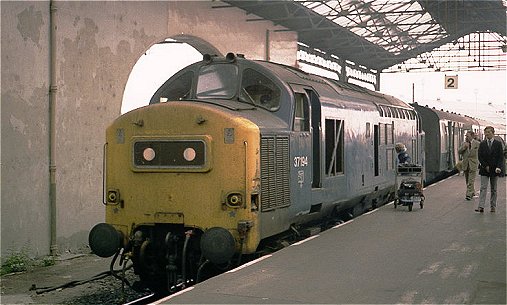Jernbane
|
Britiske Jernbaner |
|
|
|
Stemningsbillede fra Inverness - august 1979 - Kai W. Mosgaard © |
|
The rail transport system in Great Britain developed during the 19th century. After the grouping of 1923 under the Railways Act 1921 there were four large railway companies, each dominating its own geographic area: the Great Western Railway (GWR), the London, Midland and Scottish Railway (LMS), the London and North Eastern Railway (LNER) and the Southern Railway (SR). The Transport Act 1947 made provision for the nationalisation of the network, as part of a policy of nationalising public services by Clement Attlee's Labour Government. British Railways came into existence as the business name of the Railway Executive of the British Transport Commission (BTC) on 1 January 1948 when it took over the assets of the Big Four. Though there were few initial changes to the service, usage increased and the network became profitable. Regeneration of track and stations was completed by 1954. In the same year, changes to the British Transport Commission, including the privatisation of road haulage, ended the coordination of transport in the UK. Rail revenue fell and in 1955 the network again ceased to be profitable. The mid-1950s saw the rapid introduction of diesel and electric rolling stock, but the expected transfer back from road to rail did not occur and losses began to mount. The desire for profitability led to a major reduction in the network during the mid-1960s. Dr. Richard Beeching was given the task by the government of reorganising the railways ("the Beeching Axe"). This policy resulted in many branch lines and secondary routes being closed because they were deemed uneconomical. The closure of stations serving rural communities removed much feeder traffic from mainline passenger services. The closure of many freight depots that had been used by larger industries such as coal and iron led to much freight transferring to road haulage. The closures were extremely unpopular with the general public at that time, and remain so today. Ironically some of those lines have recently been reopened with the startling growth of rail traffic following privatisation of the network. Passenger levels decreased steadily from the late 1950s to late 1970s. Passenger services then experienced a renaissance with the introduction of the high-speed Intercity 125 trains in the late 1970s and early 1980s. The 1980s saw severe cuts in government funding and above-inflation increases in fares, and the service became more cost-effective. Between 1994 and 1997, British Rail was privatised. Ownership of the track and infrastructure passed to Railtrack; passenger operations were franchised to individual private-sector operators (originally there were 25 franchises); and the freight services sold outright (six companies were set up, but five of these were sold to the same buyer). The Conservative government under John Major claimed that privatisation would see an improvement in passenger services. Passenger levels have since increased to above the level they had been at in the late 1950s. (kilde: Wikipedia) |
|
|
||
|
|
|
|
|
|
|
|


